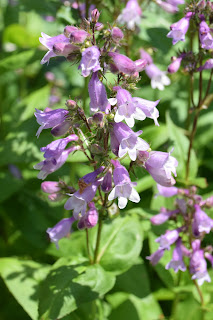I love alliteration and—when I was trying to think of
another “p” word to describe how I feel about beardtongue perennials in the
genus Penstemon—I could think of no more appropriate word than “pleasing” to describe beardtongues. These dependable, bee-supporting, and relatively deer-resistant flowers are a
favorite of mine and many other gardeners (who might not even have realized they
are native).
 |
| Penstemon tenuis in late April |
Some of you may be as surprised as I was to realize that the
very popular foxglove beardtongue (Penstemon
digitalis) has no specific records of indigenous populations. If we could
ask the herbariums what records they have, we might know better but the tool
that used to be available is no longer online (georgiaherbarium.org). This is a species that is often sold as well
as widely shared among gardeners. The burgundy-tinged cultivar ‘Husker Red’ is particularly
popular, and I have it in my garden as well.
 |
| Penstemon digitalis |
 |
| Burgundy-tinged Penstemon digitalis |
In Georgia, Penstemon flowers are white, pale lavender, and purple (and all the shades in between). The Xerces Society has a great description of beardtongue that I won’t try to restate: “Beardtongue derives its common name for the hairs that line the protruding lower petal of these tubular plants. These hairs serve an interesting function, forcing bees deeper into the flower. Some Penstemon species also have small protrusions in the flower interior that act like hooks, giving the bee a bit of a squeeze and making them struggle a tiny bit to escape. As they do so, the anthers of the flower wrap around the body of the bee, adhering pollen where it will be perfectly aligned to meet the stigma of the next flower.
If you look into the tubular flowers you’ll notice several
distinct lines leading to the back of the flower known as nectar guides. These
lines act like runway lights, advertising to bees that “the good stuff is back
here!” Source
Right now I have numerous stems of Penstemon digitalis blooming and the air is humming with the sound of bumble bees. I love to take photos of the bees going into the flowers, just their fuzzy rear hanging out.
Right now I have numerous stems of Penstemon digitalis blooming and the air is humming with the sound of bumble bees. I love to take photos of the bees going into the flowers, just their fuzzy rear hanging out.
 |
| Penstemon calycosus |
 |
| Penstemon calycosus |
These photos of Penstemon calycosus are from a small native plant nursery near me. The plants were robust and happy and full of bees. No matter which species you have, you’ll be supporting bees. I like to say that it isn’t really a picture of a beardtongue if you don’t have a bee butt in it.
Earlier my purple beardtongue (Penstemon tenuis) was blooming; just a few stray blooms remain on those plants; that is a species that is also very happy in my yard and I pot up several dozen of them each year to give away (and many friends have it now). They especially love the lawn! I originally bought several of this species from Home Depot; it was grown locally by a nursery that supplies their plants. Also blooming now is the more modest Penstemon canescens. I got this one on a rescue and my friend has propagated it from the seeds of that original plant. The foliage is slightly gray-green on that species.
 |
| Penstemon canescens |
 |
| Penstemon australis |
This photo of Penstemon australis is from a field trip with the Georgia Botanical Society. I initially was not sure if my rescued plant was this species; some folks on a Facebook group helped me understand how to tell the difference (using the angle of the stems in the panicle of blooms).
 |
| More erect on P. australis (left) vs. P. canescens |
This late spring group of plants is really a must have for the
wildlife garden and you should consider adding it if you don’t have it. I’ve
mentioned it in a number of my blogs before, including these:
So
You Want to Support Pollinators – Part 2 (the part has the plant lists
which include Penstemon)
No comments:
Post a Comment